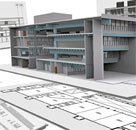| Building Information Modeling (BIM) software programs are changing the way architects, constructors, facilities managers and others do business. And Texas A&M’s College of Architecture is at ground zero, both in using and teaching the technology — and in designing its future.
BIM uses advanced software and a single digital repository to integrate information that has traditionally been managed by multiple disciplines and a variety of software. With BIM, quantity, location, quality, cost, appearance, construction scheduling and other kinds of information are managed in a common information model.
“And, in theory, all engineering analysis can also be derived from BIM,” says Mark Clayton, architecture professor and interim head of the Department of Architecture. “By combining the information essential to architects, engineers, contractors, and facility managers, BIM presents an opportunity for the industry to dramatically change its processes and patterns of responsibility. However, although likely very favorable, the costs and benefits of a BIM approach across the entire building life span are unclear.”
Clayton and architecture professors Robert Johnson and Jorge Vanegas, along with the CRS Center for Leadership and Management in the Design and Construction Industry, have received a grant from the Large Firm Round Table of the American Institute of Architects to conduct a series of discussions designed to answer some of the questions that surround the new technology. The grant will allow them to conduct a number of workshops; the first involving faculty members from programs in architecture, construction and facilities management. This group will examine BIM’s impact on concept design, schematic design and design development, construction and operations.
Another set of workshops will include faculty members in design, graphics, professional practice, project controls, construction methods, facility management, engineering and other disciplines. This group will develop a combination of information and process models to document the difference between conventional processes and BIM-assisted processes.
The final set of workshops will bring together experienced industry professionals to apply insights from practical experience with BIM. Workshop members will includes representatives from architectural design firms, construction companies, design/build firms, subcontractors and building owners, as well as members of the Large Firm Round Table, the Fully Integrated Automated Technology Consortium and the International Facility Management Association.The outcome of these workshops will be a series of reports seeking to combine the theoretical model developed by the first workshop group and a guide developed from the practical expertise of the second. These reports will be used to develop testable hypotheses about BIM, to improve its function, use and acceptance within the industry.
The college is not waiting to complete these funded research projects but is already using BIM to inform teaching, research and practice.
| |

Larger images>>
|

